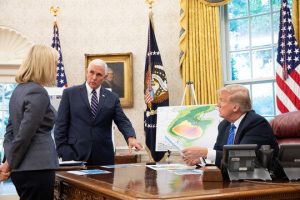
Photo: Official White House Photo by Joyce N. Boghosian
Tests of the Emergency Presidential Alert system and a nationwide FEMA alert originally set for Thursday, September 20, has been postponed to October 3, due to the ongoing catastrophe in the eastern United States created by Hurricane Florence and its remnants. With more than 30″ of rain on the ground and more on the way, FEMA resources have been deployed to help assist with that disaster along with others elsewhere in the U.S. To test the system in a quieter time, FEMA has decided to conduct the test on the back-up date rather than this week.
President Trump will be testing out the Federal Emergency Management Agency’s (FEMA) new Presidential Alert on October 3, triggering an alert on most people’s cell phones in the country. This effort will serve as a test of the national system that allows “presidential alerts” to be issued by the President to warn residents of national emergencies, such as dangerous weather. The alert from the President should come 2 minutes after another emergency alert system is tested. The test will assess the operational readiness of the infrastructure for distribution of a national message and determine whether improvements are needed.
Some cellphone users will receive a message with a header that reads “Presidential Alert.” The text then will say: “THIS IS A TEST of the National Wireless Emergency Alert System. No action is needed.”
Congress authorized the public safety alert system in 2008. It began operating in 2012 and has been used regionally; this will be the first time the alert is being used nationwide, including Hawaii and Alaska. Unlike other alerts that you can opt-out of, the law requires that you get this alert if your phone is capable of receiving them. FEMA says while phone users can opt out of the alerts for “imminent threats” and AMBER alerts about abducted children, presidential messages cannot be disabled.
The alert is set at 2:20pm ET, 1:20pm CT, 12:20pm MT, 11:20am PT, 9:20am AT, and 8:20am HT.
Two minutes prior to the presidential alert, another system will also be tested. FEMA, in coordination with the Federal Communications Commission (FCC), will conduct a nationwide test of the Wireless Emergency Alerts (WEA) system. The WEA test message will be sent to cell phones that are connected to wireless providers participating in WEA. This is the fourth EAS nationwide test and the first national WEA test. Previous EAS national tests were conducted in November 2011, September 2016, and September 2017 in collaboration with the FCC, broadcasters, and emergency management officials in recognition of FEMA’s National Preparedness Month.
The EAS is a national public warning system that provides the President with the communications capability to address the nation during a national emergency. The test is made available to EAS participants such as radio/TV broadcasters, and is scheduled to last approximately one minute. The test message will be similar to regular monthly EAS test messages with which the public is familiar. The EAS message will include a reference to the WEA test:
“THIS IS A TEST of the National Emergency Alert System. This system was developed by broadcast and cable operators in voluntary cooperation with the Federal Emergency Management Agency, the Federal Communications Commission, and local authorities to keep you informed in the event of an emergency. If this had been an actual emergency an official message would have followed the tone alert you heard at the start of this message. A similar wireless emergency alert test message has been sent to all cell phones nationwide. Some cell phones will receive the message; others will not. No action is required.”
Cell towers will broadcast the WEA test for approximately 30 minutes beginning at 2:18 pm ET. During this time, WEA compatible cell phones that are switched on, within range of an active cell tower, and whose wireless provider participates in WEA should be capable of receiving the test message. Some cell phones will not receive the test message, and cell phones should only receive the message once.